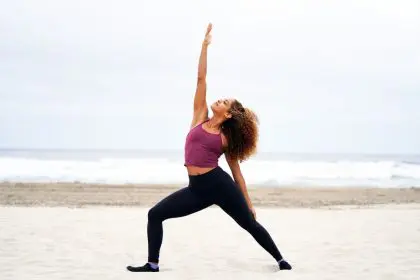Your grandmother was right about sitting up straight, but for reasons she probably never imagined. The hunched position most of us adopt throughout the day—leaning into computer screens, curving over smartphones, slouching in car seats—isn’t just unattractive. It’s triggering a cascade of physiological changes that affect everything from your mood and energy to your organ function and pain levels.
While most posture advice focuses on aesthetics or vague notions of “good alignment,” the reality runs much deeper. Your body position directly affects nervous system function, hormone production, breathing mechanics, and even digestive processes through biomechanical relationships that scientists are only now fully documenting. The modern posture epidemic represents a significant health challenge that simple awareness alone can’t overcome.
Let’s explore why certain posture-reset movements provide such profound relief, how specific positions affect your internal biology, and the surprisingly simple daily routine that can counteract hours of modern tech-induced positioning. The three-minute investment that can potentially save you years of accumulated dysfunction might be the most efficient health intervention you’re not currently practicing.
The neck-nerve connection that changes everything
The position of your cervical spine (neck) affects your entire nervous system through several specific mechanisms that explain why neck position influences seemingly unrelated body functions.
Vagus nerve compression occurs subtly but significantly when your head shifts forward from its optimal alignment atop your spine. This crucial nerve—which regulates everything from heart rate and digestion to inflammation and stress responses—becomes physically compressed when the weight of your head shifts forward by even an inch. This compression explains why poor posture correlates with digestive issues, elevated stress markers, and reduced heart rate variability in research studies.
Vertebral artery flow decreases by up to 30% during significant forward head posture according to studies using Doppler measurements. These arteries supply critical blood flow to your brainstem and cerebellum—regions controlling balance, coordination, and numerous automatic functions. This reduced circulation explains the fatigue, brain fog, and concentration difficulties many people experience after hours in compromised postures.
Cerebrospinal fluid circulation depends partly on spinal movement and positioning. This critical fluid bathes your brain and spinal cord, delivering nutrients and removing metabolic waste products. Research shows that prolonged static postures, particularly those involving forward head position, impair this flow by up to 25%. This stagnation explains why postural correction often creates immediate mental clarity improvements that seem disproportionate to the simple mechanical change.
Proprioceptive signaling—your brain’s awareness of body position—becomes distorted with consistent poor posture. The neck contains the highest concentration of proprioceptive receptors in your spine, making it particularly influential in overall body awareness. When neck position remains consistently compromised, these receptors essentially “reset” to perceive the abnormal position as normal, creating a feedback loop that perpetuates dysfunction and makes correction increasingly difficult without specific interventions.
Mechanoreceptor activation patterns in your upper cervical joints directly influence autonomic nervous system function. When these joints compress unevenly due to forward head posture, they send distress signals that trigger sympathetic (fight-or-flight) dominance. This neural connection explains why correcting neck position can produce almost immediate reductions in stress hormones and observable shifts toward parasympathetic (rest-and-digest) activity measurable through heart rate variability.
The breath mechanics that amplify energy
Beyond neural effects, posture dramatically impacts respiratory function through specific biomechanical relationships that affect oxygen uptake, carbon dioxide removal, and even energy production at the cellular level.
Diaphragmatic excursion—how fully your primary breathing muscle can contract and relax—decreases by approximately 30% in typical slouched positions. This restriction occurs because forward head posture and rounded shoulders physically compress the thoracic cavity from above while a collapsed midsection limits expansion from below. This diminished movement explains why postural correction often creates immediate sensations of “fuller” breathing without conscious respiratory effort.
Intercostal muscle engagement varies dramatically with different postures. These muscles between your ribs provide approximately 35% of normal breathing capacity, but their function diminishes significantly in hunched positions that limit ribcage expansion. The reactivation of these muscles through postural correction explains the increased oxygen saturation measurable within minutes of adopting improved alignment.
Apical lung ventilation—air movement in the upper portions of your lungs—depends heavily on thoracic positioning. When your upper back rounds and shoulders roll forward, these lung regions receive significantly reduced airflow despite having the richest blood supply for oxygen exchange. This ventilation-perfusion mismatch explains why postural correction can rapidly reduce feelings of fatigue through improved oxygen delivery to tissues.
Breathing rate regulation relies partially on posture-dependent stretch receptors in your chest and back. Poor posture distorts signals from these receptors, often leading to subtle hyperventilation patterns most people never notice. This altered breathing pattern increases sympathetic nervous system activity and disturbs blood chemistry through excessive carbon dioxide removal. Correcting posture often normalizes these breathing patterns without conscious respiratory focus.
Respiratory muscle fatigue develops rapidly in compromised postures, as accessory breathing muscles must compensate for restricted diaphragm function. These smaller muscles—not designed for continuous respiratory work—fatigue quickly, leading to progressively shallower breathing over time spent in poor alignment. This fatigue pattern explains why afternoon energy crashes often improve dramatically with brief postural reset routines that restore optimal breathing mechanics.
The spine decompression that erases pain
The vertical loading of your spine changes significantly with different postures, creating compression patterns that affect pain, inflammation, and even spinal disc nutrition through specific mechanical relationships.
Intervertebral disc pressure increases dramatically with forward head posture—by approximately 10-15 pounds of force for each inch your head moves forward from optimal alignment. This progressive loading explains why neck and upper back discomfort typically worsen throughout the day in individuals with poor posture, as discs experience cumulative compression that expels their fluid content and reduces shock absorption capacity.
Facet joint compression patterns shift with postural changes, creating uneven loading that can trigger both acute pain and progressive arthritic changes. In optimal alignment, these joints share loads relatively equally, but forward head posture dramatically increases pressure on certain facets while unloading others. This uneven compression explains the almost immediate relief many experience when specific postural corrections redistribute these forces more appropriately.
Disc rehydration occurs when compressive forces reduce during proper alignment. Spinal discs lack direct blood supply and rely on movement-driven fluid exchange for nutrition. Prolonged compression in poor postures impairs this exchange, while postural corrections that temporarily unload the spine allow rehydration. This fluid replenishment explains why brief but specific postural resets often provide relief lasting hours despite taking only minutes to perform.
Nerve root space—the openings where nerves exit your spine—changes dimension with different postures. Forward head position and rounded shoulders reduce these openings by approximately 20-30%, potentially creating pressure on nerve roots. This space reduction explains why symptoms like hand tingling, focal muscle weakness, or radiating discomfort often improve rapidly with postural correction even before any structural tissue changes occur.
Muscle tension patterns develop predictably in response to chronically poor posture, as certain muscles continuously contract to prevent further collapse while others weaken from underuse. This imbalanced tension creates compression through active muscle force rather than just gravity. Strategic postural resets interrupt these dysfunctional patterns, explaining why brief interventions can reduce pain more effectively than longer periods of simply “trying to sit up straight.”
The movement sequence that restores alignment
Specific movement combinations prove particularly effective for counteracting modern postural distortions through targeted effects on key anatomical relationships.
The chin retraction with extension represents one of the most neurologically powerful reset movements. This precise action—drawing your chin straight back and then gently looking upward—decompresses the upper cervical joints that contain the highest concentration of mechanoreceptors influencing nervous system function. The movement’s effectiveness comes from how it specifically counters the forward-down head position most common during device use.
Thoracic extension over support provides critical mobilization for the mid-back region most restricted by modern postures. By placing a rolled towel horizontally across your upper back and gently extending over this support, you create segmental vertebral movement precisely where most restriction accumulates during screen use. This targeted mobilization explains why this movement often creates immediate improvements in breathing capacity and shoulder positioning that generic “stretches” fail to achieve.
Wall angel progressions effectively address shoulder positioning through engagement of typically underactive muscles. By maintaining contact between your arms and a wall while slowly raising and lowering your arms, you activate the lower trapezius and external rotators chronically weakened in device-use postures. This neuromuscular reeducation explains why this movement improves shoulder positioning more effectively than simple positional awareness or standard stretching.
The braced core-cervical connection reestablishes the critical relationship between deep abdominal engagement and neck positioning. By gently drawing your navel inward while maintaining tall neck alignment, you activate the natural supportive synergy between these regions. This coordination pattern, typically disrupted during prolonged sitting, explains why isolated neck positioning cues often fail without corresponding core engagement.
Scapular retraction with depression counteracts the chronically elevated and protracted shoulder position common in modern postures. This precise movement—drawing shoulders down and back without chest-raising compensation—reengages the lower trapezius and serratus anterior muscles crucial for maintaining optimal alignment during daily activities. This specific activation explains why this movement creates more lasting positional improvements than passive approaches like back braces or posture reminders.
The timing strategies that make it stick
Beyond specific movements, when and how you implement postural resets dramatically affects their impact through several timing-dependent physiological mechanisms.
The transition point advantage leverages natural breaks between activities for greater neurological impact. Implementing brief resets during transitions—between meetings, tasks, or locations—coincides with your brain’s natural attention shifts, creating stronger associative learning for new movement patterns. This strategic timing explains why the same exercises performed during transitions often produce more lasting effects than longer sessions at designated “exercise times.”
The microbreak accumulation approach prevents the tissue creep that occurs with static positioning. Rather than relying on longer, infrequent corrections, implementing 15-30 second resets every 30-45 minutes prevents viscoelastic tissue deformation from becoming established. This prevention-focused timing explains why frequent mini-resets often prove more effective than longer but less frequent postural correction sessions.
The sympathetic dominance interrupt uses postural resets to break stress response cycles. Implementing specific resets when noticing stress responses—shallow breathing, increased tension, racing thoughts—leverages the direct connection between posture and autonomic function. This physiological relationship explains why postural resets often reduce stress markers more effectively than mental relaxation techniques alone, particularly during high-pressure work periods.
The pre-emptive positioning strategy implements resets before challenging activities rather than waiting for discomfort. Performing brief alignment corrections before extended device use or demanding tasks primes optimal neuromuscular recruitment patterns when they’re most needed. This anticipatory approach explains why pre-emptive resets often prevent pain development more effectively than reactive corrections after discomfort begins.
The sleep preparation sequence timing capitalizes on the neural plasticity that occurs during pre-sleep periods. Implementing specific postural resets as part of an evening routine leverages the brain’s natural preparation for memory consolidation that happens during sleep. This neurologically optimal timing explains why evening reset routines often create more lasting postural improvements than identical movements performed at other times of day.
The workspace adjustments that reinforce progress
Environmental modifications that support optimal positioning can dramatically amplify the benefits of active postural resets through several specific supportive mechanisms.
Monitor height optimization based on individual proportions rather than generic recommendations creates the foundation for sustainable neck positioning. Positioning your screen so your gaze naturally falls at approximately the top third of the screen when sitting with optimal alignment allows maintained proper position without constant muscular effort. This personalized adjustment explains why generic screen height recommendations sometimes create new problems despite theoretical correctness.
Keyboard-mouse position relationships significantly influence shoulder and upper back positioning. Placing these items at a height that allows approximately 90-110 degree elbow angles with shoulders relaxed creates the mechanical advantage needed for maintaining optimal upper body alignment without constant conscious effort. This precise positioning explains why seemingly small adjustments in work surface height often create disproportionately large improvements in sustainable posture.
The sitting-standing variability advantage comes from alternating between positions rather than choosing one exclusively. Changing positions approximately every 30-45 minutes prevents any single tissue from experiencing continuous loading patterns that lead to adaptive shortening. This variability benefit explains why movement between positions often proves more beneficial than even the “perfect” static arrangement maintained continuously.
Support surface firmness significantly affects pelvic positioning, which forms the literal foundation for spinal alignment. Surfaces that provide sufficient support to maintain approximately 110-120 degree hip angles without posterior pelvic tilting create the optimal base for spinal positioning. This foundation effect explains why seat surface modifications often improve overall posture more effectively than focusing exclusively on back positioning.
Visual environment arrangement—particularly the positioning of frequently viewed items—dramatically influences habitual head positioning. Placing commonly referenced materials at eye level rather than on flat work surfaces reduces the cumulative forward head positioning that typically accumulates throughout workdays. This strategic arrangement explains why document holders and vertical reference systems often improve neck positioning more effectively than conscious postural awareness alone.
The mindset shifts that create lasting change
Beyond physical techniques, specific psychological approaches significantly enhance postural reset effectiveness through several cognitive and emotional mechanisms.
Body awareness development—focusing on sensation rather than position—creates more sustainable improvements than external position-focused cues. Learning to recognize the feeling of optimal alignment through interoceptive awareness allows your nervous system to recognize and correct deviations without constant conscious monitoring. This sensation-based approach explains why individuals who develop this internal awareness maintain better posture in varied environments compared to those relying solely on external reminders.
The energy-posture connection recognition leverages the immediately perceptible benefits of proper alignment for motivation. By explicitly noting the improved energy, clearer thinking, or reduced tension that follows postural resets, you create powerful reinforcement that mere knowledge of long-term health benefits rarely provides. This immediate feedback recognition explains why individuals who consciously connect posture to subjective well-being typically maintain corrections more consistently than those motivated primarily by distant health concerns.
Movement permission psychology represents a crucial shift from viewing posture as “holding still correctly” to understanding it as fluid, adaptive positioning. This conceptual reframing—recognizing that good posture actually involves frequent small position changes rather than rigid maintenance of a single “correct” position—allows more sustainable approaches that work with rather than against your body’s natural movement needs.
Environmental cue integration—using existing habitual triggers to prompt postural resets—creates more consistent implementation than scheduled reminders that often get ignored. Associating brief resets with already-established habits like checking email, phone notifications, or drinking water leverages existing neural pathways rather than requiring entirely new habit formation. This psychological integration explains why tying resets to existing behaviors typically creates more lasting behavior change than isolated posture-specific reminders.
Identity-based approach effectiveness comes from incorporating postural awareness into your self-concept rather than viewing it as an external requirement. The shift from “I should fix my posture” to “I am someone who values and maintains body alignment” creates more consistent behavior through identity-congruent actions. This psychological reframing explains why identity-based approaches typically maintain better long-term adherence compared to knowledge or fear-based motivational strategies.
The relationship between posture and overall health extends far beyond appearance or even immediate comfort. Your physical positioning directly affects neurological function, hormone production, respiratory efficiency, and countless other physiological processes through biomechanical relationships that can either support or undermine your body’s optimal function.
What makes postural resets particularly valuable in our modern context is their remarkable efficiency—the ability to create significant physiological benefits through brief, simple interventions that require no special equipment and can be implemented almost anywhere. In an increasingly time-constrained world, few health practices offer comparable return on time investment.
Perhaps most importantly, regular postural resets provide a practical counterbalance to the unprecedented postural challenges created by our device-centered lifestyle. Rather than fighting against technology use, these strategic movements offer a practical way to maintain physical wellbeing while still participating fully in our digital environment.
The three-minute investment in postural resets represents not just pain prevention but a legitimate contribution to your overall physiological function, energy levels, and even cognitive performance. In the complex equation of modern health, few variables offer such significant influence with such minimal investment as the way you hold and move your body throughout the day.















